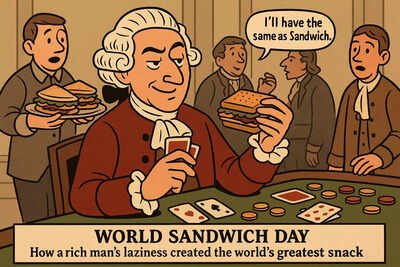World Sandwich Day: How a gambling addict created the world’s greatest snack |

Somewhere in 18th-century England, a man too addicted to gambling to pause for dinner stumbled upon the world’s most democratic invention. John Montagu, the 4th Earl of Sandwich, unwilling to leave his gaming table, asked a servant to bring him roast beef tucked between two slices of bread. It allowed him to eat without interrupting his vice or dirtying the cards. His fellow gamblers began asking for “the same as Sandwich,” and thus, through an act of aristocratic laziness, the modern sandwich was born.Of course, people had been wrapping food in bread long before Montagu. The ancient Jews had lamb with matzah, the Greeks had gyros, and the Indians had parathas and kati rolls. But history rarely rewards invention; it rewards branding. The Earl didn’t invent the sandwich, he named it. And like most white people, got the credit for non-white solutions. And naming is how civilisation turns accidents into myths.Every year, on November 3rd, the world honours that glorious accident on World Sandwich Day, a celebration of the meal that lets us multitask through modernity: eat, move, scroll and survive.
The Philosophy of the Sandwich
Defining a sandwich sounds simple until you try it.What exactly qualifies? Must it be two slices of bread? Does a burger count? A wrap? A taco? Somewhere, someone once decided this mattered. And because this is humanity, we took it to court.In 2006, a Massachusetts judge presided over White City Shopping Center v. PR Restaurants, a case in which Panera Bread tried to block Qdoba Mexican Grill from opening nearby. The lease said no other “sandwich” shop could operate in the plaza. Panera argued that burritos were sandwiches. The court disagreed. A burrito, the judge ruled, is not a sandwich, since it’s made with a single tortilla, not two slices of bread.And that’s how an American courtroom immortalised the absurdity of modern civilisation: a judge deciding, in black-letter law, that a burrito is not a sandwich.Philosophically, the question runs deeper. The sandwich isn’t just food; it’s a concept, the act of edible containment. It’s bread as architecture, filling as essence, civilisation as structure enclosing chaos. To hold a sandwich is to hold the illusion that the messy stuff of life can be neatly contained between two slices of order.The Earl of Sandwich didn’t just create a meal. He created a metaphor for existence.
The World in a Bite
An estimated billion sandwiches are consumed globally each day. The United States alone devours around 300 million daily, enough to feed almost the entire population once over. The British eat twelve billion a year, most of them purchased in cling-wrapped triangles from supermarkets, a quiet ritual of lunch-hour melancholy.Every culture has its own variant. The Vietnamese bánh mì—a French baguette filled with pickled vegetables and pork—turns colonial trauma into culinary triumph. The Bombay sandwich piles potatoes, chutneys and spice into a stack that mocks the blandness of British legacy. The torta in Mexico, the shawarma roll in the Middle East, the Smørrebrød in Scandinavia—all regional responses to the same existential question: how do you hold life in your hands without letting it fall apart?Each sandwich tells a story of globalisation, trade, migration and adaptation. It’s history you can bite into, portable proof that civilisation’s progress often begins with someone saying, “I don’t have time for a plate.”
Sandwich as Civilisation
If bread represents order and the filling represents chaos, then every sandwich is an edible philosophy. Between the slices lies the entire drama of human existence: structure holding together substance, convenience containing complexity.Civilisation functions exactly like that. We build institutions, laws and borders, our bread, to hold together the unpredictable filling of life. The sandwich, then, is not merely lunch. It is a metaphor for our daily compromise between stability and desire.The beauty of the sandwich is its lack of hierarchy. It belongs equally to the construction worker and the corporate CEO, the schoolchild and the scholar. It can be devoured in seconds or crafted like art. It travels well, offends no gods and adapts to every culture that adopts it.In the post-industrial world, where time is rationed and hunger is scheduled, the sandwich is our last act of autonomy. It says: I may not have an hour for lunch, but I will not go hungry.The holy trinity of breakfast rebellion — bacon, lettuce, and tomato, proving that virtue (lettuce) only exists to highlight sin (bacon). A sandwich that tastes like a lazy Sunday pretending to be healthy.
Reuben
An immigrant’s fever dream turned deli masterpiece — corned beef, sauerkraut, and Russian dressing in an edible Cold War. It’s what happens when America decides to pickle its guilt and serve it on rye.
Club Sandwich
The bourgeoisie’s architectural marvel: three layers, two toothpicks, zero shame. It’s not lunch — it’s a real estate deal between bacon, turkey, and self-importance.
Cheeseburger
Democracy between buns — the meat sweats, the cheese melts, and everyone pretends it’s not political. One bite and you understand why America will never be vegan.
Bombay Chilli Cheese Toast
Colonial hangover meets street-smart swagger — buttered bread with rebellion between slices. It’s the only toast that can start a conversation and a riot at the same time.
The Sandwich and the Soul
In a sense, we are all the Earl of Sandwich now, addicted to our own endless games, too busy to sit down, feeding our appetites between deadlines and dopamine hits. The sandwich is our perfect companion: functional, adaptable, endlessly customisable and quietly tragic.It lets us believe we’re being efficient while we devour the hours we’ve lost. It lets us pretend that nourishment and productivity can coexist. It’s the edible embodiment of modern life’s contradiction: we crave comfort, yet we can’t stop moving.Perhaps that’s why the sandwich endures. It’s not just convenience; it’s confession. Between those slices of bread lies a portrait of who we’ve become—civilised, restless and forever hungry.So today, on World Sandwich Day, as you bite into your BLT, your grilled cheese, your vada pav or your bánh mì, remember the unlikely philosopher who made it all possible: a gambler who couldn’t leave the table, and a civilisation still pretending it can.Because in the end, the sandwich isn’t just something we eat. It’s what we are, a fragile structure of order and chaos, held delicately together by the hope that everything won’t fall apart before the next bite.
var _mfq = window._mfq || [];
_mfq.push([“setVariable”, “toi_titan”, window.location.href]);
!(function(f, b, e, v, n, t, s) {
function loadFBEvents(isFBCampaignActive) {
if (!isFBCampaignActive) {
return;
}
(function(f, b, e, v, n, t, s) {
if (f.fbq) return;
n = f.fbq = function() {
n.callMethod ? n.callMethod(…arguments) : n.queue.push(arguments);
};
if (!f._fbq) f._fbq = n;
n.push = n;
n.loaded = !0;
n.version = ‘2.0’;
n.queue = [];
t = b.createElement(e);
t.async = !0;
t.defer = !0;
t.src = v;
s = b.getElementsByTagName(e)[0];
s.parentNode.insertBefore(t, s);
})(f, b, e, ‘https://connect.facebook.net/en_US/fbevents.js’, n, t, s);
fbq(‘init’, ‘593671331875494’);
fbq(‘track’, ‘PageView’);
};
function loadGtagEvents(isGoogleCampaignActive) {
if (!isGoogleCampaignActive) {
return;
}
var id = document.getElementById(‘toi-plus-google-campaign’);
if (id) {
return;
}
(function(f, b, e, v, n, t, s) {
t = b.createElement(e);
t.async = !0;
t.defer = !0;
t.src = v;
t.id = ‘toi-plus-google-campaign’;
s = b.getElementsByTagName(e)[0];
s.parentNode.insertBefore(t, s);
})(f, b, e, ‘https://www.googletagmanager.com/gtag/js?id=AW-877820074’, n, t, s);
};
function loadSurvicateJs(allowedSurvicateSections = []){
const section = window.location.pathname.split(‘/’)[1]
const isHomePageAllowed = window.location.pathname === ‘/’ && allowedSurvicateSections.includes(‘homepage’)
const ifAllowedOnAllPages = allowedSurvicateSections && allowedSurvicateSections.includes(‘all’);
if(allowedSurvicateSections.includes(section) || isHomePageAllowed || ifAllowedOnAllPages){
(function(w) {
function setAttributes() {
var prime_user_status = window.isPrime ? ‘paid’ : ‘free’ ;
var geoLocation = window?.geoinfo?.CountryCode ? window?.geoinfo?.CountryCode : ‘IN’ ;
w._sva.setVisitorTraits({
toi_user_subscription_status : prime_user_status,
toi_user_geolocation : geoLocation
});
}
if (w._sva && w._sva.setVisitorTraits) {
setAttributes();
} else {
w.addEventListener(“SurvicateReady”, setAttributes);
}
var s = document.createElement(‘script’);
s.src=”https://survey.survicate.com/workspaces/0be6ae9845d14a7c8ff08a7a00bd9b21/web_surveys.js”;
s.async = true;
var e = document.getElementsByTagName(‘script’)[0];
e.parentNode.insertBefore(s, e);
})(window);
}
}
window.TimesApps = window.TimesApps || {};
var TimesApps = window.TimesApps;
TimesApps.toiPlusEvents = function(config) {
var isConfigAvailable = “toiplus_site_settings” in f && “isFBCampaignActive” in f.toiplus_site_settings && “isGoogleCampaignActive” in f.toiplus_site_settings;
var isPrimeUser = window.isPrime;
var isPrimeUserLayout = window.isPrimeUserLayout;
if (isConfigAvailable && !isPrimeUser) {
loadGtagEvents(f.toiplus_site_settings.isGoogleCampaignActive);
loadFBEvents(f.toiplus_site_settings.isFBCampaignActive);
loadSurvicateJs(f.toiplus_site_settings.allowedSurvicateSections);
} else {
var JarvisUrl=”https://jarvis.indiatimes.com/v1/feeds/toi_plus/site_settings/643526e21443833f0c454615?db_env=published”;
window.getFromClient(JarvisUrl, function(config){
if (config) {
const allowedSectionSuricate = (isPrimeUserLayout) ? config?.allowedSurvicatePrimeSections : config?.allowedSurvicateSections
loadGtagEvents(config?.isGoogleCampaignActive);
loadFBEvents(config?.isFBCampaignActive);
loadSurvicateJs(allowedSectionSuricate);
}
})
}
};
})(
window,
document,
‘script’,
);
Source link




